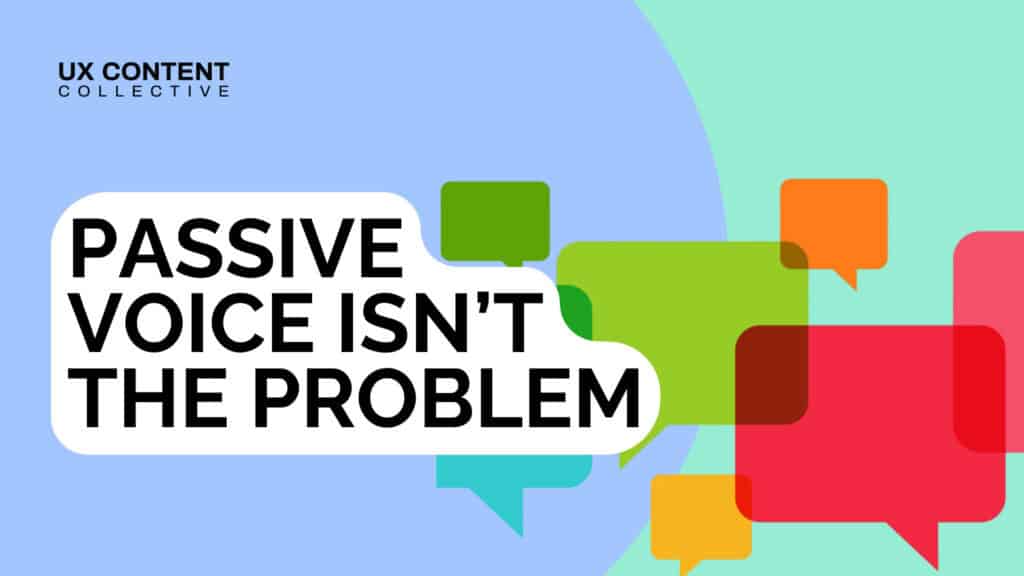

Interested in UX writing and content design?
Explore our content design and UX writing training:

Interested in UX writing? Check out our complete guide to UX writing and content design.
Ah, passive voice. The two words that have haunted writers since high school English class. You might still hear the voice of your high school English teacher lecturing, “Active voice is strong. Passive voice is weak. Period. End of discussion.”
Or maybe you’ve faced the smug, digital scolding of a grammar checker (Grammarly, I promise, I’m not talking about you), accusing your prose of crimes against clarity or engagement. Passive voice has been dragged through the mud for decades. It’s vague, they say. Weak! Lacking command!
But passive voice isn’t the villain of the story—it’s just misunderstood.
While active voice gets all the glory for being clear and strong, passive voice quietly works behind the scenes to smooth out friction, emphasize user outcomes, and soften the occasional blow.
So, let’s stop treating passive voice like it’s the cilantro of grammar (misunderstood, but secretly essential. I cook a lot, and I don’t know how to use cilantro, but I know it smells great) and give it the redemption it deserves.
Passive voice 101: what’s the deal?
Passive voice happens when the object of an action becomes the subject of the sentence.
Hang tight—it’s simpler than it sounds. But let’s make it practical with an example:
Here’s a quick everyday example:
- The dog chewed his owner’s shoe
- The owner’s shoe was chewed by the dog
Now, here’s a UX example:
- Active voice: “We updated your account.”
- Passive voice: “Your account has been updated.”
In the active voice, we (the doer) take center stage. In the passive voice, the spotlight shifts to your account, the user’s account (the receiver of the action). It’s like a grammatical costume change, but the meaning stays the same.
So, why all the hate? Well, it’s been accused of being vague, overly formal, and just plain boring. And yeah, if you use it indiscriminately, it can sound robotic. But guess what? When used with intention, passive voice can make your writing more empathetic, clearer, and—dare I say—easier for users to digest.
Remember, in UX writing, it’s not about what’s grammatically “pure.” It’s about what works for the user.
Why passive voice deserves a spot in your UX writing
1. Passive voice puts users in the spotlight
Great UX writing is like a good selfie; it is user-centered, and passive voice has a sneaky way of doing it. By focusing on the object (the user’s stuff) instead of the subject (you, your company, or your system), passive voice keeps the spotlight where it belongs: on the user.
For example:
- Active voice: “We’ve updated your account.”
- Passive voice: “Your account has been updated.”
Both sentences are technically correct, but see how the passive version shifts the focus? It’s not about who updated the account (spoiler: they don’t care). It’s about what happened to the account. Subtle, but it makes the message feel more relevant and user-centered.
Think about it: when was the last time you read a notification and thought, “Wow, I really needed to know who was responsible for this action”? Exactly.
2. Passive voice simplifies your message
Users are busy. They’re scrolling through notifications while juggling a coffee cup and, perhaps, a toddler or racing to complete a task before their lunch break ends. The last thing they need is a sentence that makes them stop and think.
Consider this:
- Active voice: “We’ve processed your request.”
- Passive voice: “Your request has been processed.”
In the second version, the company fades into the background, leaving a clean, straightforward message. Users don’t need to know who processed their request—it’s implied. What matters is the outcome, and passive voice gets straight to the point.
3. Passive voice softens the blow
Here’s the thing about UX writing: sometimes, you’ve got to deliver bad news. Whether it’s an error message, a delay, or something worse, you don’t want to sound like you’re pointing fingers or scolding the user. Passive voice is like your chill friend who knows how to diffuse tension.
For example:
- Active voice: “We suspended your account due to a violation.”
- Passive voice: “Your account has been suspended due to a violation.”
Notice the difference? The active version feels a little… harsh. It calls attention to the company’s role in taking action, which can come across as blamey (is that a word? It should be). The passive version, on the other hand, focuses on the event, not the actor. It’s less personal and more neutral—and that’s exactly what you want when delivering sensitive messages.
Where passive voice shines bright like a diamond
1. Confirmation messages
When users finish a task, they’re looking for one thing: reassurance. Passive voice delivers it with simplicity and focus.
- Passive: “Your order has been placed.”
- Active: “We’ve placed your order.”
The passive version skips the unnecessary mention of the company and centers on the user’s success. It’s a subtle tweak, but it makes a world of difference.
2. Error messages
Nobody likes being told they’ve messed up. Passive voice can soften the tone and make errors feel less accusatory.
- Passive: “Your payment could not be processed.”
- Active: “We couldn’t process your payment.”
By focusing on the outcome, not the actor, the passive version keeps things neutral and user-friendly. No finger-pointing here.
3. Notifications and updates
When it comes to status updates, passive voice helps keep the focus where it belongs—on the user.
- Passive: “Your account has been updated.”
- Active: “We’ve updated your account.”
Again, the passive version prioritizes the user’s experience over the company’s action. It’s subtle, but it works.
When to use passive voice: a cheat sheet
Here’s a quick guide for deciding whether passive voice is the way to go:
1. Who’s the star of the sentence?
- If it’s the user, passive voice can help center them.
- Example: “Your password has been changed.”
2. Do users need to know who did the thing?
- If not, skip it.
- Example: “The form has been submitted.”
3. Will active voice sound too harsh?
- Use passive voice to soften the tone.
- Example: “Your account has been suspended.”
A few caveats
Now, before you go slapping passive voice on everything, a word of caution: too much of a good thing can make your writing sound impersonal or stiff. Balance is key. Use it when it serves the user, but don’t shy away from active voice when clarity or energy is needed.
So, is it perfect?
Nope. If you overuse it, your writing can sound detached or robotic. But when used thoughtfully, it’s an incredibly useful tool—especially in UX writing. It puts users first, simplifies communication, and helps you deliver messages with empathy.
Passive voice might not get the glory, but it’ll make your users’ lives a whole lot easier.



